Article
The uncertain future of Meaningful Use
Just when physicians thought Meaningful Use would never end, the Centers for Medicare and Medicaid Services (CMS) announced in January that the current program would go away this year. But it’s already clear that while Meaningful Use will change, it’s far from dead.
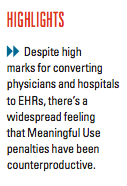
Just when physicians thought Meaningful Use would never end, the Centers for Medicare and Medicaid Services (CMS) announced in January that the current program would go away this year. But it’s already clear that while Meaningful Use will change, it’s far from dead.
MIPS: The ‘death knell’ for small practices?
Medical associations and physicians have expressed both optimism and concern regarding the recent pledge by CMS Acting Administrator Andy Slavitt that the Meaningful Use program will end in 2016 and be replaced by “something better.”
It’s a good sign that Slavitt went as far as he did in making that statement, says Wanda Filer, MD, president of the American Academy of Family Physicians (AAFP). “When you see a program that has gone as far off the rails as the Meaningful Use program, it shows some leadership to be able to say we’ve got a problem here and we know it needs to change.”
Nevertheless, Filer and other observers say that they’ll have to learn the details of CMS’ new program before they can decide whether it makes sense. Slavitt indicated that those details would be available within a few months.
David Blumenthal, MD, president of The Commonwealth Fund and a former national coordinator for health IT, cautions that the law that established the Meaningful Use program has certain requirements that the head of CMS can’t set aside on his own.
“There’s a long way to go between now and a termination of Meaningful Use,” he said.
Indeed, Slavitt’s January remarks at the J.P. Morgan Annual Health Care Conference in San Francisco raise many questions, ranging from what will replace the current program to whether non-attesting physicians will still be liable for penalties to whether the EHR certification program will continue in its current form.
Next: CMS' game plan
Nobody knows the answers yet. But a close look at Slavitt’s remarks with some expert assistance yields useful insights into what might lie ahead.
CMS’ game plan
At the J.P. Morgan conference Slavitt said, “Now that we effectively have technology into virtually every place care is provided, we are now in the process of ending Meaningful Use and moving to a new regime culminating with the MACRA [Medicare Access and CHIP Reauthorization Act] implementation. The Meaningful use program as it has existed, will now be effectively over and replaced with something better.”
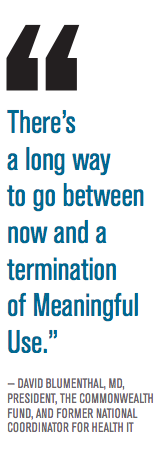
In his speech, Slavitt said that the program’s emphasis will shift from the use of the technology to patient outcomes. He also said, “Providers will be able to customize their goals so tech companies can build around the individual practice needs, not the needs of the government. Technology must be user-centered and support physicians, not distract them.”
Slavitt noted as well that CMS is requiring “open APIs [application programming interfaces]” that will allow physician organizations to use outside apps and will make it easier to “get data in and out of an EHR securely.” Lastly, he said CMS is “deadly serious” about interoperability and will ensure it can be applied in “critical use cases like closing referral loops and engaging a patient in their care.”
How to navigate the medical marijuana dilemma
All of this is consistent with what CMS said last year when it announced the final rule for changes to Meaningful Use stage 2 requirements and for stage 3 requirements. The agency explained that it was going to transition the EHR incentive program into the framework of the Medicare Access and CHIP Reauthorization (MACRA) legislation, which will combine Meaningful Use with the Physicians Quality Reporting System (PQRS) and the value-based modifier program as part of the Merit-Based Incentive Program (MIPS).
Next: Should you breathe a sigh of releif?
MIPS is a pay-for-performance program that is one of two tracks that physicians can choose for Medicare reimbursement under MACRA. (The other consists of “alternative payment models” [APMs] such as accountable care organizations and patient-centered medical homes.)
If physicians select MIPS, they will be measured on their quality, efficiency, practice improvement activities, and meaningful use of EHRs. The resulting scores will increase or decrease their Medicare income 4% in 2019, rising to 9% in 2022.
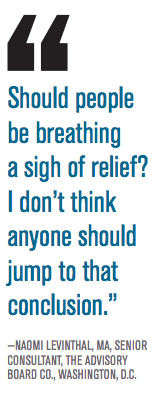
How perverse incentives are ruining healthcare
Because CMS usually has a two-year interval between performance and payment adjustment in its programs, some observers believe that CMS plans to introduce a new and improved Meaningful Use program next year as part of MIPS. If so, how physicians perform not only on Meaningful Use but also on the other three components of MIPS will determine how much they are reimbursed by Medicare in 2019.
The week after Slavitt’s speech, he and Karen DeSalvo, MD, MPH, the national coordinator for health IT, published a blog post clarifying some of Slavitt’s remarks. Among other things, they made it clear that the incentives and penalties under Meaningful Use will continue.
Bernie Sanders’ ‘Medicare-for-all’ gets mixed reviews by physicians
That means physicians who did not attest to Meaningful Use for 2015 (and did not qualify for an exemption) will still be penalized in 2017, and those who fail to show Meaningful Use this year will receive payment adjustments in 2018. These payment incentives can be adjusted under MACRA but will continue, Slavitt and DeSalvo said.
The penalties for not demonstrating Meaningful Use are required through 2024, notes Naomi Levinthal, MA, a senior consultant with the Advisory Board Co., a Washington, D.C.-based healthcare consulting firm.
The CMS blog post also pointed out that, until the upcoming MACRA regulations are finalized, the current Meaningful Use rules will remain in force, including those for stage 3.
Next: MU challenges
Meaningful use challenges
None of this answers the burning question of what physicians will be expected to do under the successor to the Meaningful Use program. But doctors do have some very clear ideas about what’s wrong with Meaningful Use, what they don’t want to do and what they can’t do.
For example, Filer notes, “One of our objections along the way has been that physicians are being penalized for something entirely out of their control.” In this category are the stage 2 and 3 requirements that a certain percentage of patients view, download, or transmit their health records electronically.

Edward Gold, MD, an internist in Emerson, New Jersey, notes that his 68-doctor group recently attested to stage 2, but wouldn’t have been able to do so if CMS hadn’t lowered the threshold for this objective from 5% of patients to a single patient. While some physicians were able to meet the original requirement, not all were.
“It wasn’t just signing up with the [patient] portal and going to the portal,” Gold points out. “The patients had to access the portal, they had to get their results, and they had to send a note back to us” to meet the view-download-transmit and other criteria for patient engagement.
If stage 3 were to go forward as planned, it would raise the threshold for view-download-transmit to 10% and for secure messaging to 25% of patients seen.
Another problem has been the lack of interoperability between EHRs, which has made it difficult for physicians to exchange care summaries at transitions of care, one of the requirements for attesting to stage 2 of Meaningful Use. Gold’s group has had trouble with this requirement, he says, partly because there are no functioning health information exchanges in its area. Direct secure messaging is also problematic, he explains, because not many other practices use the health information service provider (HISP) that his group does, and the local HISP cannot communicate with each other.
Next: Physicians react
Yul D. Ejnes, MD, an internist in Cranston, Rhode Island, says that his 100-physician group was able to exchange the requisite care summaries. But he is concerned that it would be a much bigger challenge to meet the higher stage 3 thresholds for information exchange and patient engagement.
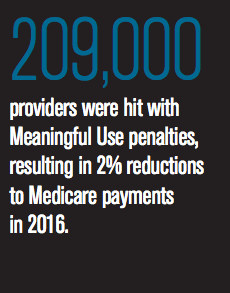
Ejnes, who views the new CMS stance as a “positive development,” notes that when he receives a care summary from another provider or a report from a hospital, it arrives in the form of a PDF document. He has to leave his workflow to find the document, search for the data he needs, and come back to the electronic chart. If he wants to add that piece of data to the chart, he must enter it manually. “There’s nothing that’s extractable” in PDFs, he says.
Terry Hashey, DO, who leads a two-doctor family practice in Jacksonville, Florida, also was able to exchange care summaries as part of his attestation to Meaningful Use stage 2. His EHR can route individual data elements from a standardized clinical summary into the correct fields. But this takes eight to 10 minutes per chart, because he has to click on each piece of data to acknowledge or delete it. In the end, the information he received from other providers was not helpful. So he just accepted enough care summaries to meet the Meaningful Use requirement.
Top 10 challenges facing physicians in 2016
One reason for this disconnect, Hashey says, is that the EHR vendors are being pushed to meet short deadlines for certification, so they do a “halfway job” and are too busy to improve their products.
Hashey is concerned about the stage 3 requirements, but he also worries his practice won’t be able to keep up if CMS ends stage 3 and introduces the MIPS program too rapidly. What could happen, he says, is that the government “will require me to use a technology that doesn’t exist to modify patient behavior that I don’t truly control with a deadline that is unfair.”
Hashey says his practice will continue trying to improve quality and outcomes. That fits with the shift in the Meaningful Use program’s emphasis from checking boxes on technology use to improving outcomes with the help of EHRs. But that goal won’t necessarily be easier for physicians to deal with than is the Meaningful Use program.
Next: Will it be simpler?
“Is that going to be simpler?” asks the Advisory Board’s Levinthal. “Should people be breathing a sigh of relief? I don’t think anyone should jump to that conclusion, because arguably, that would be harder than the [current] Meaningful Use requirements.”
Because MIPS is going to be so difficult for doctors, she adds, MACRA includes a financial allocation to revive the health IT regional extension centers that helped small practices implement EHRs and show Meaningful Use in stage 1.
QUALITY MEASUREMENT
EHRs will be used for quality measurement both in MIPS and the alternative payment model track. Many practices are already traveling down that path by electronically reporting PQRS data, which CMS has aligned with Meaningful Use’s quality reporting criteria and is used in the value-based modifier. For example, both Gold’s and Ejnes’ groups are using the Group Practice Reporting Option (GPRO) to report quality data just once for Meaningful Use, PQRS, and the Medicare Shared Savings Program for the ACOs they belong to.
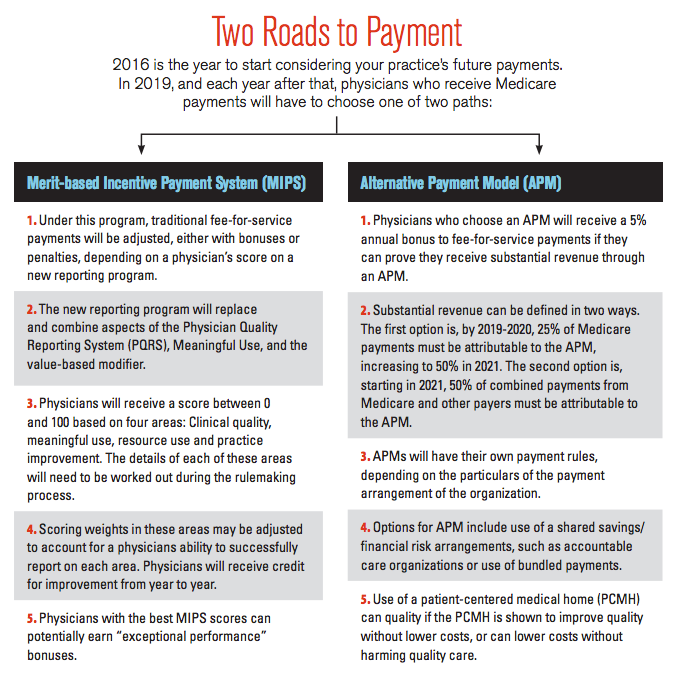
But this simplification is not as straightforward as it seems, especially for small practices that have been using special Medicare codes to report PQRS data. To switch to EHR reporting, practices not eligible for GPRO must use a qualified clinical data registry provided by a third party or must use expensive, glitchy software provided by EHR vendors to report directly to CMS.
David Kibbe, MD, president of DirectTrust, a trade association for Direct messaging participants, says that many issues still need to be resolved for efficient quality reporting, including what is to be measured, how to store the information in EHRs so that data can be extracted automatically, and how to extract the data in a standardized format. He predicts that smaller groups will have to use some kind of clearinghouse to clean up and normalize their data for quality reporting.
“Many practices worry that they won’t be able to do this or it’s going to cost them a ton of money,” he says. “The vendors, for the most part, are way behind them. The EHR certification criteria aren’t zeroing in on that at all.”
Hashey expresses another concern: “If they really start squeezing down on outcomes, what’s to stop doctors from firing their noncompliant patients, and only keeping the compliant ones? Who’s going to take care of the patients who need the most help?”
Next: EHR certifications
EHR Certifications
EHR vendors have told their customers that their ability to innovate and to produce more usable, interoperable EHRs has been limited by their need to rewrite their software to meet changing EHR certification requirements. Only EHR technology certified by government-appointed firms can be used in demonstrating Meaningful Use.
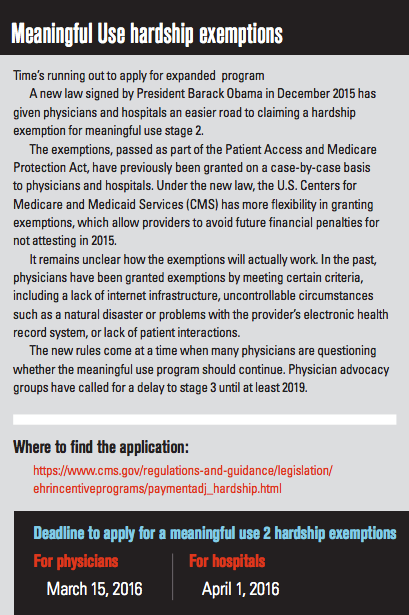
Yet the end of “Meaningful Use as we know it” is unlikely to alter the EHR certification process, says Levinthal. Certified EHRs are required for PQRS, and they will be needed to show meaningful use in MIPS, she says. In addition, APMs will be required to use certified EHRs. And hospitals, which are not covered under MACRA, will still have to use certified EHRs to show meaningful use.
The alignment of EHRs with MACRA, Kibbe says, will probably occur in three areas: care coordination, patient engagement and quality reporting. All three will require interoperability, which Slavitt stressed in his remarks. But as Filer notes, the kind of innovation required for that and for other EHR improvements is not in evidence.
“We’ve offered to work with CMS going forward to cultivate a program that will improve quality and promote innovation in the next generation of EHRs, something that’s less clunky than what we work with today,” AAFP president Filer says. “Unfortunately, the Meaningful Use program seems to have almost put innovation on the back burner.”
Health IT could help lower cost and improve quality, “but we need the technology to work and we’re not there yet,” she continues. “So if there’s some way to hold vendors’ feet to the fire and say let’s work on innovation instead of penalizing us, that would go a lot further.”
Next: Market forces vs government regulations
Market forces vs government regulations
While observers and medical associations give the initial phase of the Meaningful Use program high marks for converting most physicians and hospitals to EHRs, there’s a widespread feeling that stage 2 and the Meaningful Use penalties have been counterproductive. Moreover, physicians don’t understand why they should continue having to prove they are using EHRs meaningfully after having demonstrated they are doing so.
“When MIPS arrives, do we need Meaningful Use?” Ejnes asks. “I think it needs to go away. There are [performance] measures you can’t do without an EHR, so why do we need to prove we’re meaningfully using it?”
Steven Waldren, MD, director of the AAFP’s Alliance for eHealth Innovation, points out that Meaningful Use may be an obstacle to improving the quality of care. “Doctors and their practices have a finite capacity, and many times they’re taking that capacity and going through the routine of being compliant on Meaningful Use, which may or may not improve the quality of care they provide to their patients.”
Like Filer, Waldren believes that physicians are revolting against too much government regulation of their daily work. “If this continues, docs will get a sour taste in their mouth and not continue to do the transformational work that will prepare them for value-based reimbursement,” he says.
Waldren agrees that EHR vendors have lagged in areas such as interoperability, user-centered design and population health management. But he thinks that value-based reimbursement will give healthcare providers a strong incentive to demand more from them.
“We’ve been doing Meaningful Use now for five years,” he observes. “How much has it really helped us on quality and cost efficiency and the Triple Aim? I’d say it has helped us marginally, and we’ve spent billions of dollars. Will the market be able to do that? That’s a big unknown, and it may not be able to do any better.”
Next: Failures
The Commonwealth Fund’s Blumenthal, who directed the government’s health IT enterprise during the first stage of Meaningful Use, has a different view. “If the healthcare market functioned like other markets, Meaningful Use and the HITECH law would have been unnecessary,” he points out. But in many cases, the market has failed to engender the innovations that are needed to move healthcare forward, he says.
For example, he argues, EHR vendors never would have provided patient portals and clinical decision support features on their own, if not for Meaningful Use.
Another failure of both vendors and providers, he says, is the inability to create interoperability among EHRs. “The technology could be there if people really wanted to do it. The problem is that the market doesn’t work. In theory, everyone wants to exchange information; in practice, very few people actually do it. And vendors don’t want to do it, either.”
Nevertheless, Filer, for one, remains optimistic that CMS will create a better program that will not only be less intrusive, but will spur the kind of progress that will make EHRs easier to use and more useful. “If we could have a high functioning, interoperable EHR that allows me to get information on patients, that would be great. We all support that idea and the promise of it, but we haven’t seen it yet.”





